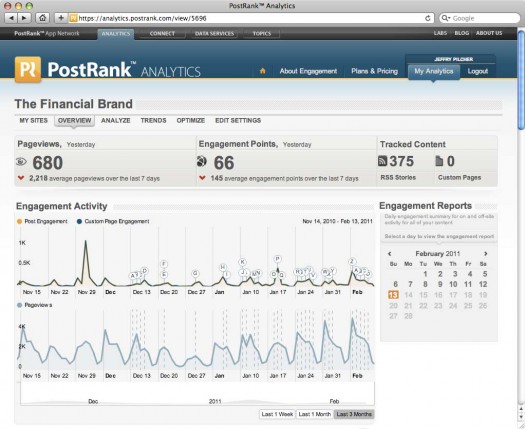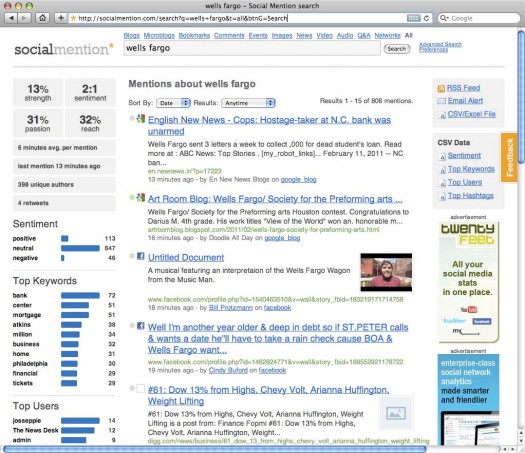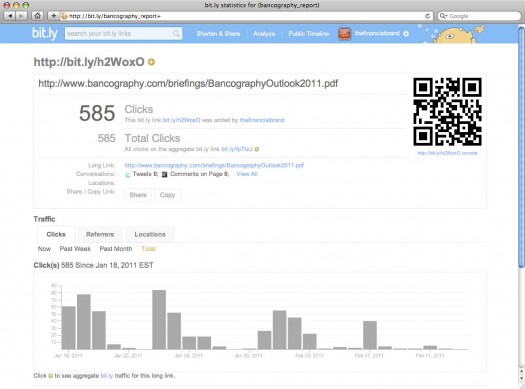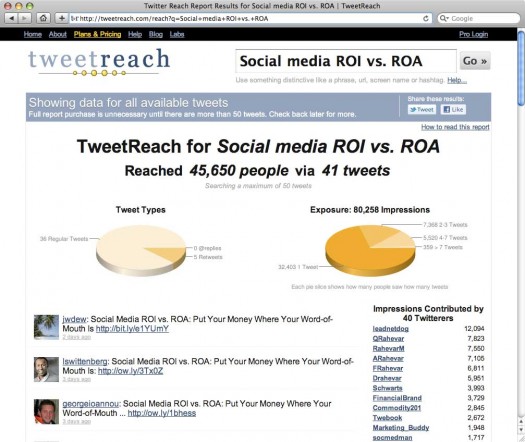Executives responsible for bank and credit union brands will increasingly need tools to monitor, manage and measure their online/social media activities. The Financial Brand evaluated and reviewed 11 free online resources to help get you started.
Those tools with a green checkmark ![]() are regularly used and highly recommended by The Financial Brand.
are regularly used and highly recommended by The Financial Brand.
Twitter Sentiment
Twitter Sentiment is a simple web-based application that counts and compares the number of positive vs. negative tweets for a search term, graphing them out over a selected time frame: one day, 5 days, one month, 3 months, 6 months and one year.
Pros: The interactive slider on the graph allows you to visually select a certain time period.
Cons: The data is one-dimensional, and subject to false-positives.
TWITTER SENTIMENT FOR WELLS FARGO
3,994 positive tweets and 5,798 negative tweets about Wells Fargo in the last year.
| Brand | Negative Mentions |
Neg. % |
Positive Mentions |
Pos. % |
|---|---|---|---|---|
| Wells Fargo | 3,981 | 40.8% | 5,773 | 59.2% |
| BofA | 1,495 | 39.9% | 2,256 | 60.1% |
| Citi | 7,036 | 59.7% | 4,753 | 40.3% |
| Barclays | 1,555 | 55.3% | 1,258 | 44.7% |
| HSBC | 5,133 | 45.2% | 6,212 | 54.8% |
| BECU | 14 | 48.3% | 15 | 51.7% |
| Westpac | 726 | 56.9% | 549 | 43.1% |
| Nike | 93,763 | 70.7% | 38,914 | 29.3% |
| Disney | 436,676 | 77.2% | 128,881 | 22.8% |
 PostRank
PostRank
PostRank is an excellent social web analytics tool, enabling more effective discovery of where your audience is engaging with your online content. PostRank can analyze any kind of online content, including RSS feeds, video, downloads, etc., by monitoring real-time online conversations at over 20 top social networks. If your financial institution is active in a number of social media channels (a blog and Twitter account, for instance), you should sign up for PostRank’s free daily email updates. It will really give you an accurate measure of whether your social media activities are resonating with people or not.
POSTRANK SOCIAL MEDIA ANALYTICS
The Financial Brand has connected its website and Twitter account to yield a range of interesting PostRank statistics.

Instant Messaging. Instant Impact.
Connect with your customers and provide lightning-fast support as effortlessly as texting friends. Two-way SMS text messaging is no longer optional.

Why Industry Cloud for Banking?
PwC’s Industry Cloud for Banking helps deliver personalized products and services that today’s customers expect.
Google Alerts
[Editor’s Note: Advice retracted. The Google Alert system no longer functions properly/at all. For more details, see this post here.]
It’s seldom The Financial Brand can give unequivocal advice: Everyone should be using Google Alerts at some level in their organization. With Google Alerts, you can automatically receive on-going email updates whenever Google finds new search results on terms important to your organization’s brand.
For example, if you are (the imaginary) XYZ Credit Union in Seattle, you might want to create Google Alerts for various combinations of your name. You might want to monitor any mentions of your CEO, Steven Mason. You could monitor a struggling competitor down the street, Seattle Pacific Bank. And you might want to receive all the latest news on credit unions in the Seattle area. Savvy users can turn their Google Alerts into RSS feeds.
In this day and age, everyone simply must have advanced Google search skills. One cool feature is the ability to search for sites linking to yours. Just search for “link:www.yoursite.com.” In the following example, we are asking Google to send an email whenever anyone links to the XYZ Credit Union website anywhere on the web:
Pros: Google finds everything. Simple, intuitive interface.
Cons: Google finds too much. You will likely have to massage and refine your search terms using advanced operators. For instance, The Financial Brand must modify its Google Alert search for “bank advertising” to exclude -“food” and -“blood” banks.
Tip: Use Google Alerts to monitor your personal brand (and perhaps your kids’ online reputations as well).
Socialmention
Socialmention takes Google Alerts to the next level. The site monitors your brand’s mentions from all across the social web, including Facebook, Twitter, Youtube and Flickr, aggregating content into a single (and very thorough) stream of information.
There is a robust dashboard loaded with information, including the last time the brand was mentioned, how long ago, how many unique individuals are talking about the brand, how many retweets, etc.
Pros: Comprehensive search of multiple social media platforms. Lots of metrics. You can create email alerts and RSS feeds, and export data to a CSV/Excel file.
Cons: It chokes on any search involving more than one word (e.g., “Bank of America” or “Navy Federal”). Shows only a few days data for some search terms. The data is subject to false-positives.
Scores are assigned according to four factors: strength, passion, sentiment and reach.
| Financial Brand | Positive Mentions | Pos. % | Negative Mentions | Neg. % | Neutral Mentions | Neut. % |
|---|---|---|---|---|---|---|
| Wells Fargo | 80 | 9.2% | 52 | 6.0% | 734 | 84.8% |
| BofA | 66 | 7.9% | 60 | 7.2% | 713 | 85.0% |
| Citi | 71 | 9.4% | 30 | 4.0% | 657 | 86.7% |
| Barclays | 152 | 17.4% | 26 | 3.0% | 696 | 79.6% |
| HSBC | 86 | 10.4% | 20 | 2.4% | 717 | 87.1% |
| Navy Federal | 104 | 20.4% | 20 | 3.9% | 385 | 75.6% |
| BECU | 95 | 16.0% | 22 | 3.7% | 476 | 80.3% |
| Westpac | 100 | 12.3% | 36 | 4.4% | 674 | 83.2% |
 Tweetdeck
Tweetdeck
It’s nearly impossible to manage a professional Twitter account using Twitter’s website interface. All serious social media managers rely on a desktop application like Tweetdeck that enables them to organize tweets. Tweetdeck splits tweets into columns, classifying them by topic or group. You can instantly create a new column to show tweets about a certain search term.
Similar free platforms like Hootsuite and Seesmic do pretty much the same thing. There are also enterprise-level solutions like CoTweet and Sales Force. Radian6 is one of the most robust social media management tools out there, used by many big brands.
Pros: iPhone version.
Cons: You’ll probably have 5+ columns of tweets which takes up a lot of screen space.
TWEETDECK
You can set up keyword search terms to create columns where all the tweets mentioning you or your product are displayed.

 Bit.ly
Bit.ly
If you’re sharing links on social websites like Facebook and Twitter, how do you know how many (if any) people are clicking on them? Don’t you want to know how many people clicked on the link to your latest press release about an upcoming branch grand opening? You can do this with Bit.ly.
Go create an account (it’s free), then shorten your website links at Bit.ly before sharing them on Twitter or Facebook. You’ll have a complete and accurate count of every click for every URL — in realtime, right down to the minute.
Pros: Graphs with click-through data. Can customize shortened URLs. Automatically generates QR codes.
Cons: Anyone can look up the click-through stats for a Bit.ly URL simply by adding a “+” sign to the end of it.
Bit.ly allows users to shorten, share, and track links (URLs).
Reducing the URL length makes sharing on social sites easier.
TweetReach
TweetReach gives you detailed reach analysis for any search term on how tweets about that term have spread on Twitter. See how many different users received tweets about your topic. Pro versions available.
Pros: Investigate your impact. Identify your influencers. TweetReach is ideal for tracking hashtags, especially for events.
Cons: Your search term must contain a unique phrase, otherwise your results will contain tons of extraneous garbage.
An example of a TweetReach stats for an article The Financial Brand recently published.

Navigating the Role of AI in Financial Institutions
83% of FI leaders agree investing in AI is essential for 2024 but how you leverage AI is instrumental in success and meeting customer expectations.
Read More about Navigating the Role of AI in Financial Institutions

How Banks Are Fortifying Their Data Against Increasing Cyber Threats
This webinar from Veeam will detail the value of working together across your organization to be better prepared in cyber defense and response readiness.
Read More about How Banks Are Fortifying Their Data Against Increasing Cyber Threats
 Twitter Advanced Search
Twitter Advanced Search
With Twitter’s Advanced Search engine, you can type in any search term and whammy, you get a instant snapshot of all the most recent tweets about your subject.
If your financial institution serves a limited geographic region, you may want to follow conversations specific to your local area. Under the “Places” section of Twitter’s Advanced Search page, you can request results from within a certain distance of a specified location.
Pros: The interface has a lot of different options, and is fairly intuitive. You can create an RSS feed out of any of your searches, making it easy and automatic to stay current on important conversations or topics.
Cons: Unless your organization is really large, you aren’t going to find many mentions. If your financial institution shares a common name, you’re going to get confusing results.
Negative comments about “credit unions” on Twitter.
Topsy
Unlike traditional web search engines, Topsy indexes and ranks search results based upon the most influential conversations about specific terms, topics, pages and domains. Topsy’s algorithms dynamically identify influencers within the social web for any searchable criteria, using these influence calculations to rank results.
Topsy displays realtime results for related terms & articles, trending topics, identifies experts (influencers) for any queried term and shows you trackback pages for everything in its index, displaying what everyone is saying about that query.
Pros: The quality of results is high — only relevant material is displayed. You can create both email alerts and RSS feeds from your Topsy queries.
Cons: It provides only data. You’ll need other tools to address any issues you uncover.
TOPSY STATS FOR BANK OF AMERICA
Topsy identifies salient tweets about BofA. On the left, there are tweet counts for the past hour (15), the past day (250), the past four days (1,895), the past week (3,117), the past month (18,000) and all-time (201,000).

BackTweets (Service No Longer Available)
Enter your website address or other URL at BackTweets and see how many times people have shared a link to it on Twitter. An upgraded version includes tweet counts, impressions, reach and other statistics.
Pros: It finds and deciphers shortened URLs like those from Bit.ly. You can receive email alerts.
Cons: No RSS feed. And Twitter bought up Backtweets… then killed the service, so it is no longer available.
BACKTWEETS FOR THE FINANCIAL BRAND
There were 493 people linking to The Financial Brand’s website on Twitter in a two week period.
Klout
Klout scores are the measurement of your influence. Scores range from 1 to 100, with higher scores representing a wider and stronger sphere of influence. Klout uses over 35 variables on Facebook and Twitter to measure True Reach, Amplification Probability and Network Score.
Klout puts you into one of 16 possible classifications based on factors such as how often you tweet, who you follow, who follows you and how your audience interacts with your messages. Your Klout classification is like a personality test for your style of influence.
Klout also displays your “Influence Network,” showing who you influence and who influences you. Influence is determined by a variety of factors including retweets, @messages, follows and lists.
Pros: Seeing your Twitter profile dissected. Comparing your Klout score to rivals. Third-party feedback about how you might be perceived.
Cons: The data isn’t really all that important or actionable.
INGDIRECT’S KLOUT SCORE = 56


















